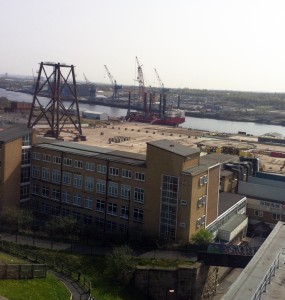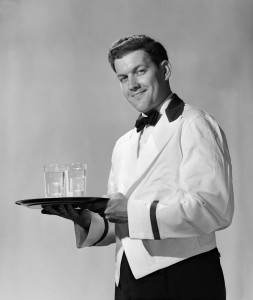In Wallsend I heard a shipyard joke; Bobby slept in so he was late for work at Swan Hunter‟s. When he finally got there the gates were locked, so he climbed in over the wall. The foreman saw him and said to Bobby, “You‟re sacked.”
Bobby cried out, “But I‟ve brought me bait (his sandwiches).”
“Oh, alright then” said the foreman “I‟ll sack somebody else!”
I thought this was very funny at the time, except when it almost happened to me in Whitby.
In my first year at Sunderland Art College in 1954, unsure of what I wanted to do, I had a taster of a couple of Courses. Beginning with Fashion Design, this was very short-lived and then Graphic Design, before Fine Art and sculpture.
I had ballet lessons after classes. I listened to gramophone recitals at lunchtime. These were the initiative of Herbie Simpson, a Classical music enthusiast and our drawing teacher. He wore a hearing aid. He was deaf in one ear, (to speech that is.) He shared his passion for great music, Til Eugenspiegel! and Rite of Spring, with the little group that listened with him every Monday.
Separate from the main building of the College and across Backhouse Park, stood The Cedars, formerly a very grand house adapted for use by Fine Art, Painting and Sculpture, which occupied rooms rather than studios.
The basement was actually a billiards room, complete with a table that was piled high with old and no longer used curtains. Other add-ons included a conservatory with plants. This was a good room for drawing and made a welcome change from the antique, anatomy and perspective lessons that took place in the main building.
I escaped to The Cedars to begin Intermediate Sculpture with Jock Miller. The first task, using modelling clay, was to make a small variation of a Henry Moore Mother and Child. I cast this using a piece of thread that followed the silhouette of the clay sculpture. Covering the whole with a layer of plaster and at the right moment and with a little help from a friend, pulling the thread taut to separate the setting plaster into the two halves of a mould. These were soaped clean and then filled with plaster to make the cast.
The next part of the process – chipping out – was the difficult bit. During this procedure heads, arms, noses and feet were often knocked off by inexperienced hands that were unused to mallet and chisel; the stable where we were working looked like a miniature field hospital.
For the Intermediate exam I carved a cat in beechwood. Jock having returned to Glasgow, left Hughie and me without a sculpture tutor, so I availed myself of Herbie Simpson’s knowledge of cat anatomy. My sculpture was packed in a box and with life drawings and a painting in gouache plus sketch-books, sent off to London to be given a mark, what it was I never knew, only that I had passed. On its return I sold my cat sculpture to the dinner lady for 10/-.
The year before I moved into Sculpture, Fenwick Lawson, a carver of great skill then and now, and like me a recipient of the Sir James Knott Travel Award, had been the occupant of the sculpture room. I had swopped him an adze for the book Picasso’s Sculpture, a volume I still cherish. Fenwick left the North-East only long enough to study at the Royal College of Art. When Hughie and I began sculpture, another student, Dennis O’Connor was just completing his Diploma course, he was good at drawing, especially ballerinas. Dennis was also destined for the Royal College and the Drawing Prize.
Two successful students who were London bound decided me to specialise in sculpture for the next two years towards my NDD, Hughie Clarke had already opted to do this. There were only two of us, with the large room to ourselves. We moved in as Jock Miller moved out, so we were left to fend for ourselves – well almost. From the few books in the sculpture cupboard Hughie ‘borrowed’ Henry Moore and I chose Marino Marini and there were sporadic interventions from Harry Thubron and his sidekick Bob Jewell. In year three we were taught by Wendy Pasmore – I made an abstract carving in fruit wood.
During my first year, I was friendly with Stan Woodward, a design student. I spent Sunday evenings at his home in Easington Village watching television, specifically The Sunday Play. A characteristic of mining villages in the 1950s was the forest of TV aerials that were sprouting from the roof tops. This was before we had our own set at Saltburn Road, a set with back projection, it was sophisticated technology that delivered an inferior picture.
Anyway, Stan and I applied to The Royal Hotel on the cliff top at Whitby for a summer job.
It was from the window in his room at the Royal that Bram Stoker, looking across the port and out to sea began writing his great novel, Dracula.
The response to our enquiry was positive and we bought our white waiter’s jackets as instructed, packed a bag and set off to work as hotel porters in Whitby for six weeks. However we arrived to hear from the owner, Mr Hindmarsh, that the vacancies had been filled. “But we’ve already bought our porter’s jackets,” we shrieked.
“Ah then,” said Mr. Hindmarsh, “I‟ll sack the other two and you can start tomorrow!”
As well as carrying bags we had extra duties. At breakfast I was in charge of tea and coffee, (sometimes hot water, when I forgot to put the teabag into the pot!) Mr Hindmarsh was often present first thing, scraping the vestiges of butter from the wrapping paper. This was my first lesson in how to be a millionaire. One lunchtime the secret of the unnaturally green peas served at The Royal was revealed when a penny was found on a plate. At dinner I was the wine waiter but before I undertook that job, every evening, without exception, I carried a boiled chicken up to the owner’s flat. Mr Hindmarsh had been a successful ballroom dancer but an accident had put an end to his career and left him permanently disabled.
I don’t remember the amount of the weekly wage handed to us by our employer each Friday, usually accompanied by a progress report. Unopened I sent my pay packet home. Why did I do this? Anyway, tips and a small profit from wine and spirit sales were enough pocket money for me.
We made friends with the Chef. I painted his portrait. He had very red face. Thereafter, cooked salmon steaks would often appear in our room when we returned there at the end of the day.
I had a Holiday Romance. For almost two weeks, (the time of her holiday,) on afternoons only; that is, during daylight and if I could get away, I would walk along the sands with a very, very young woman and snatch a secret kiss.
From time to time the hotel staged special events and extra waiting staff were brought in to help, one of these assistants was called Mary, a married woman with a child. I found her very attractive. Actually, she was irresistible to a young virgin. We kissed and cuddled one evening and thereafter when an opprtunity presented itself. On my day off we even sat on the beach together, a foolish indiscretion that not surprisingly led to angry scenes with Mary’s husband. However, being more careful, our dangerous involvement lasted for another week or so, until, as a parting gift to me, we had sex in the woods. My first time, it was over before it got started, but served to make me the envy of my friends at college when I told them I was no longer pure! Mary sent me a leather wallet that October, a birthday present. It is in drawer of the desk that I am writing on. Like the owner, it is worn but still intact. I wrote a Thank you as a last goodbye.
Stan Woodward went home early because his dog died, so I did not go to London from Whitby as we had planned. Instead I went in the opposite direction, north-west to Glasgow with a man of my own age called Bruce, a trainee manager. His stint at The Royal was finished and he drove me in his MG, to his home in Lockerbie. I stayed overnight at the family pub and next morning travelled by train to Glasgow, to Kelvingrove Art Gallery where I was very taken with Christ of St John of the Cross by Salvador Dali.

